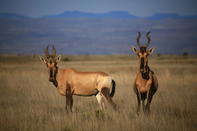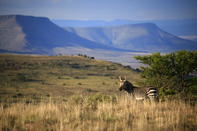Early Inhabitants
The Mountain Zebra National Park has acted as a backdrop for thousands of years of human history. Around 12 000 years ago, Later Stone Age people inhabited the area where the park now stands.

Evidence of their stay can be found along the banks of the Wilger River. Through research conducted by the University of Stellenbosch, 30 sites with pottery and stone artifacts have been identified in the area.
The San people occupied the area around 300 years ago. Three rock shelters containing rock art from the era have been identified, and depicts various animals like antelope and baboons, as well as humans. These painting sites are accessible if you hire a park guide to accompany you on the route to the ancient artwork.
Establishment of the Park

During the Anglo-Boer War in the 1800s, British soldiers occupied the Saltpeterskop, a high koppie in the park where they would ‘play chess’ - a strategic game to signal warnings to their fellow soldiers who were stationed at an old fort in nearby Cradock. The names of the soldiers are etched onto a flat slab at rock on the koppie.
During the Great Trek of 1836, settlers moved into the area and set up farms. One of the first permanent farmhouses was erected on the farm De Doornkloof. It was declared a national monument in 1986. It is still in use today as a guest house in the Park.
In 1937, 1 712 ha of land was set aside and proclaimed as the Mountain Zebra National Park. The endangered Cape mountain zebra survived in the area due to the conservation efforts of farmers in the region. The herd in the park has grown substantially and is now over 350 strong. The park slowly expanded over the years and grew rapidly after a joint public-private conservation initiative was launched. Nine surrounding farms were purchased through this process, enabling the Park to expand from 6 536 ha to more than 28 000 ha in size. Following this, black rhino, buffalo and finally cheetah could be introduced to the Park.